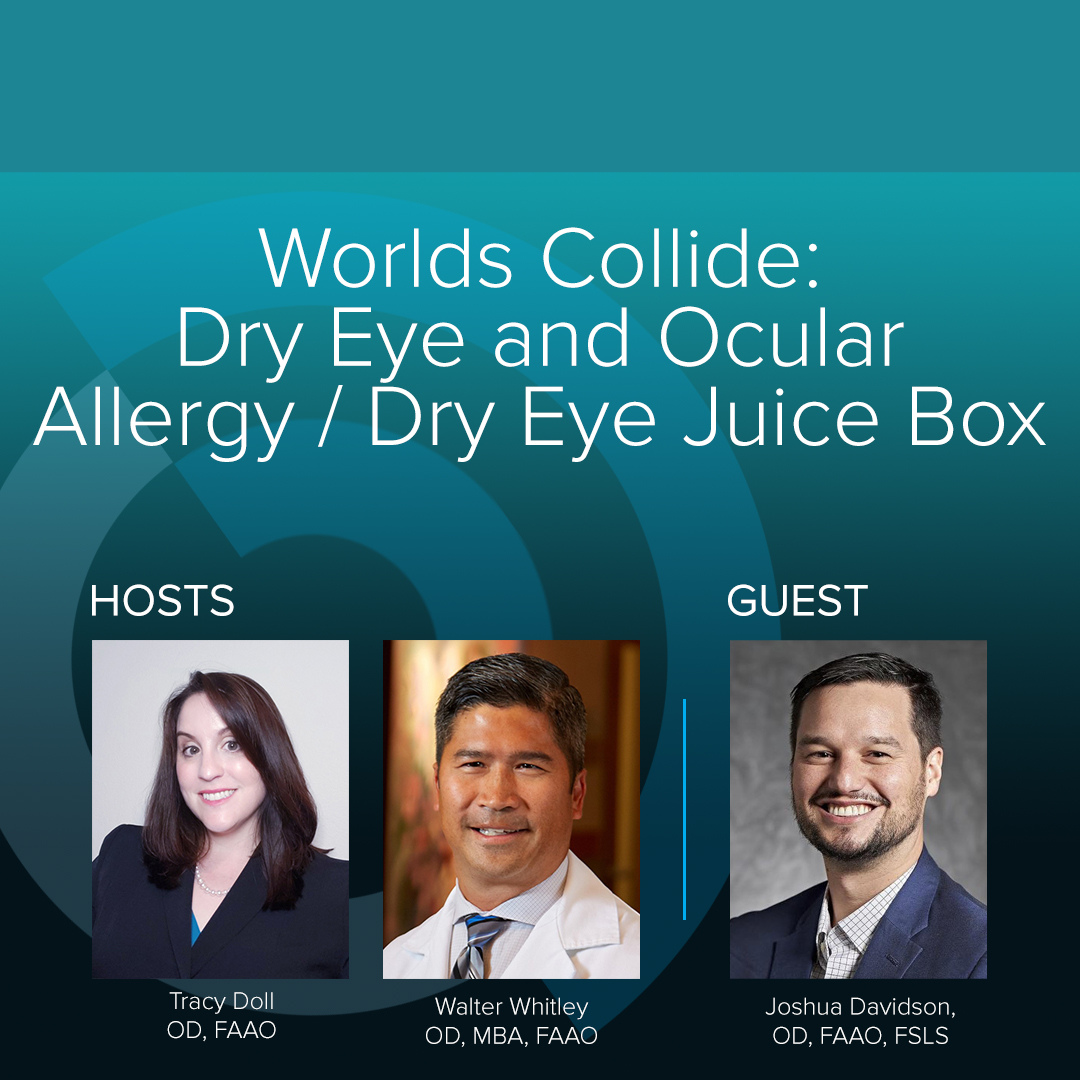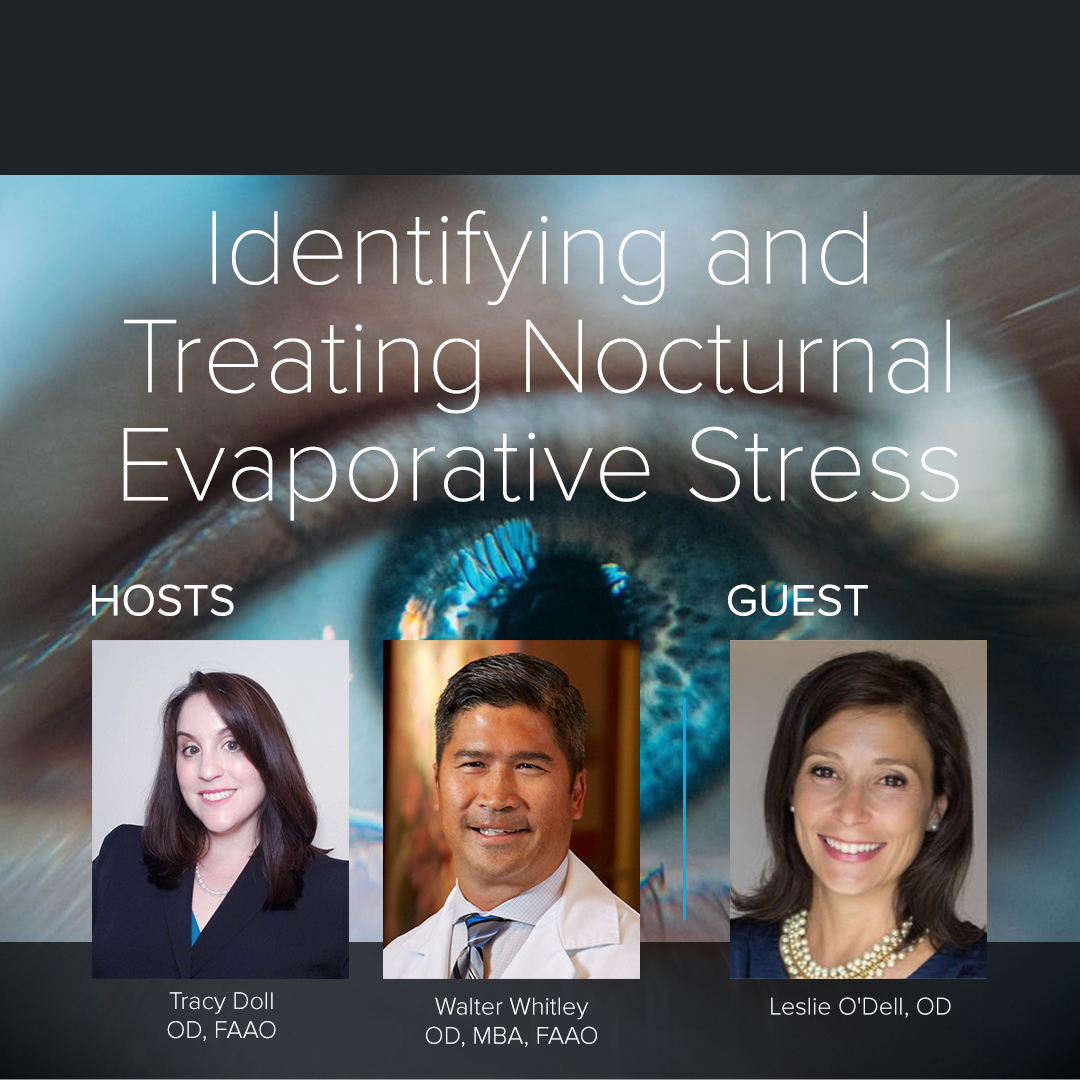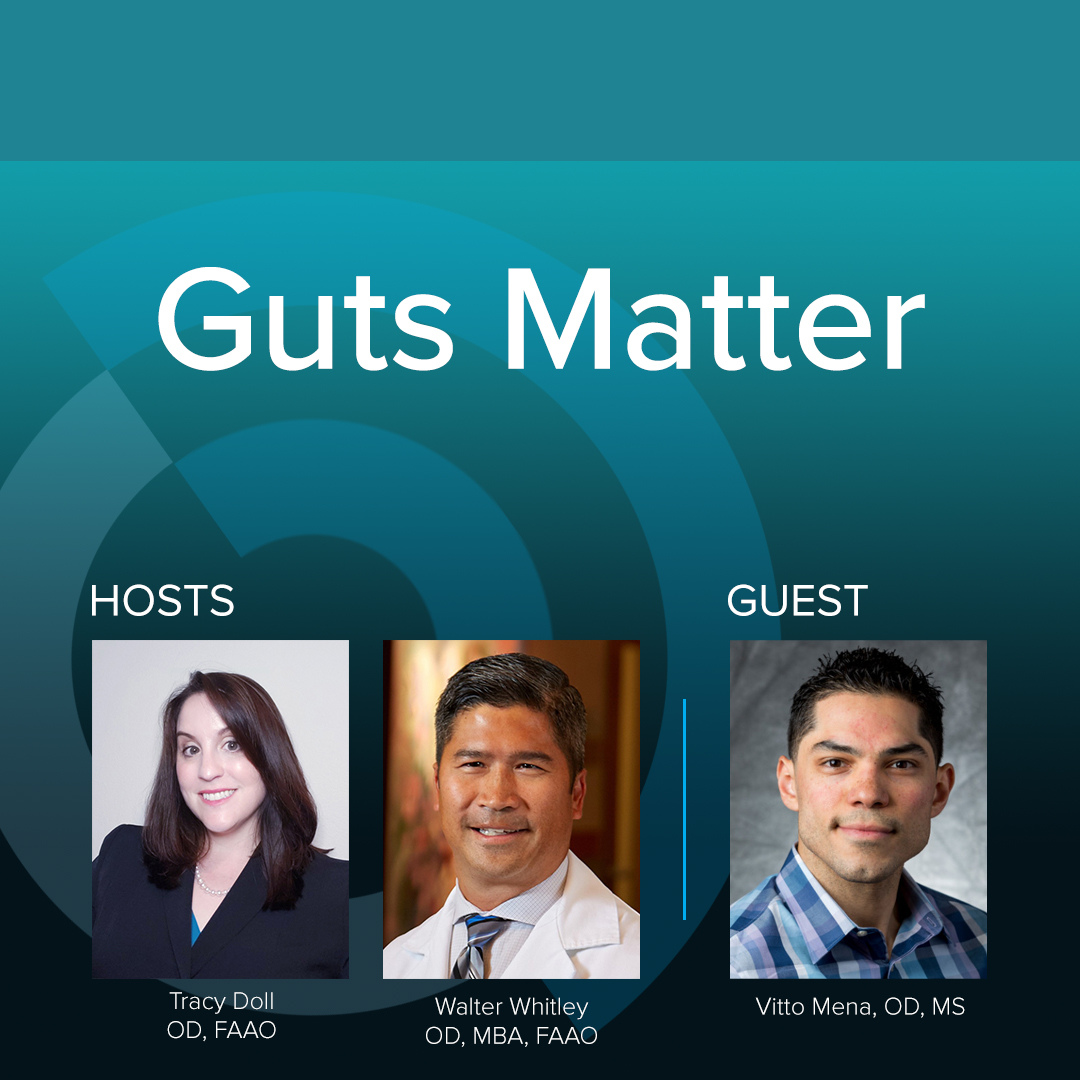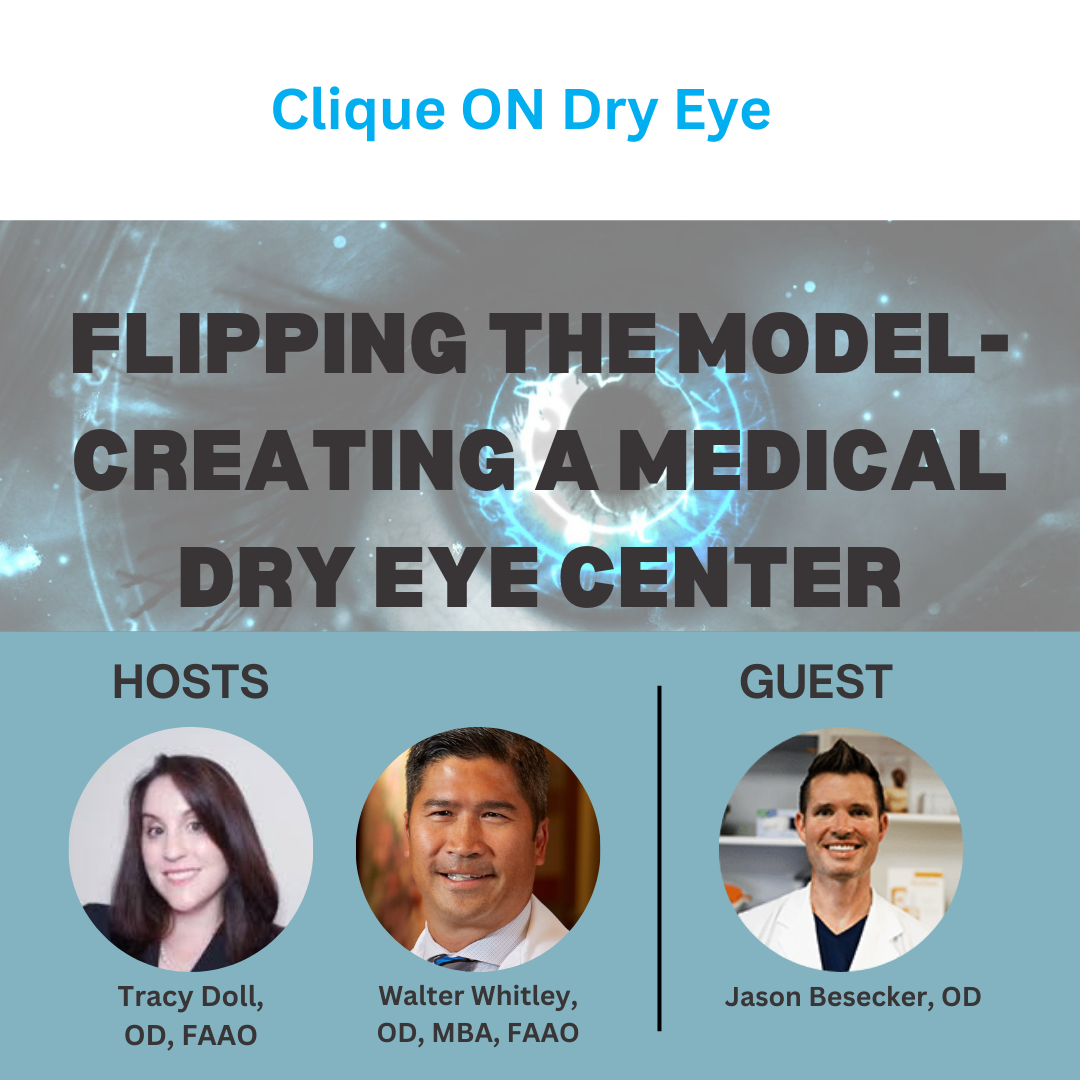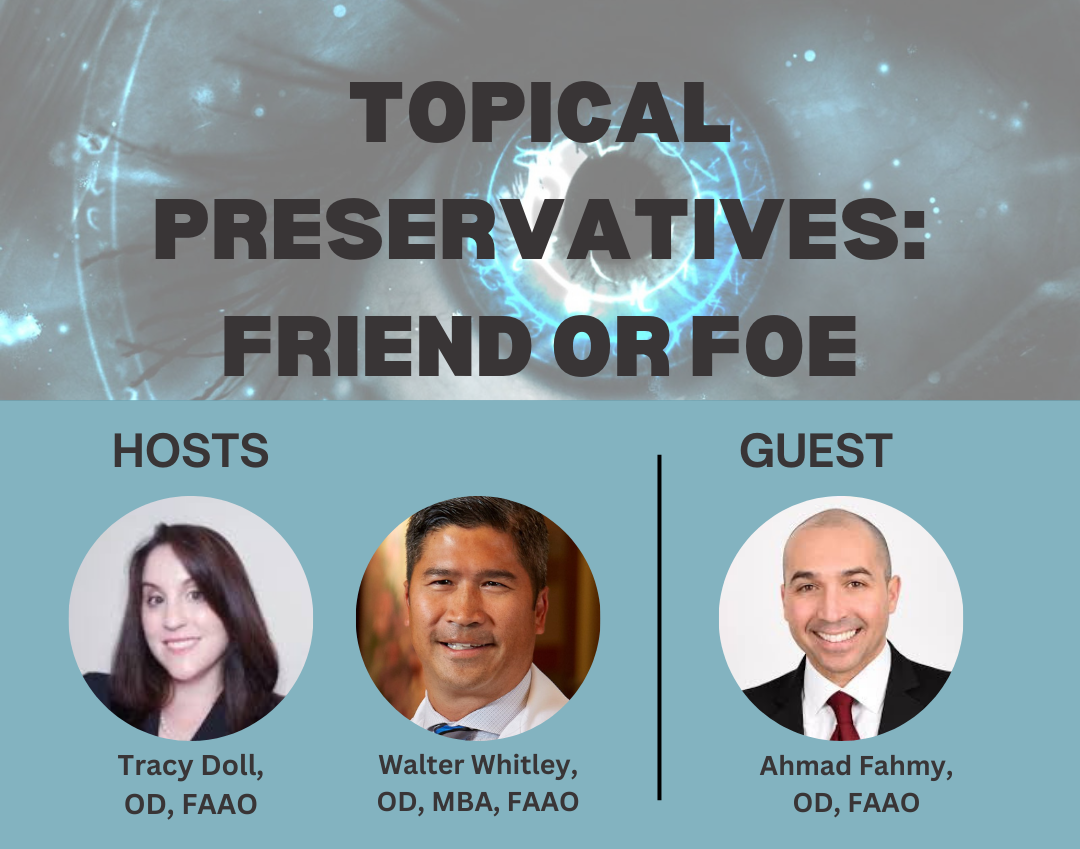Episode Transcript
[00:00:00] Speaker A: Welcome to the Dry Eye podcast series. Click on dry Eye, your insider paths to the most exclusive dry eye topics. The series will raise awareness about the current and future state of ocular surface disease. The podcasts will focus on a variety of topics. Before we get to our next episode, here's a quick word from our sponsor.
[00:00:19] Speaker B: In today's episode, we have the pleasure of speaking with Doctor Hardeep Kataria, who practices as a medical optometrist at a multi specialty ophthalmology group focusing primarily on the management of medical glaucoma and dry eye. Welcome, Hardy.
[00:00:33] Speaker C: Thank you so much to Walt and Tracy for having me here. I really appreciate the invitation.
[00:00:37] Speaker B: Hey, can you tell us a little bit about your practice and how you got into dry eye?
[00:00:41] Speaker C: Yeah, absolutely. So I was brought on into the retina clinic to focus on medical glaucoma management. And about a year in, I actually went in asking the ophthalmologist not to put me into the dry eye clinic because I wasn't interested in treating dry eye. And then about a year in, I would feel so burdened by the patients coming in and complaining of their symptoms of dry eye, and I felt like I had a really huge hand in that because I was putting them on glaucoma medications. And so that's how the dry eye clinic evolved. And I really love focusing on the intersection of glaucoma and dry eye in the practice, especially when it comes to enhancing patients quality of life.
[00:01:23] Speaker B: Yeah, we've talked about this before. You have a glaucoma practice. You have a dry eye practice for sure?
[00:01:28] Speaker C: Yeah, absolutely. There it is.
[00:01:31] Speaker B: What practice are you at right now?
[00:01:33] Speaker C: It's advanced eye specialists in just north of La, California. Okay.
[00:01:38] Speaker B: Okay, well, can you tell.
[00:01:40] Speaker A: West coast. Yay.
So can you tell us a little bit? We brought you on states because I know that you like working with all different types of dry therapies. So can you tell us what are biologics?
[00:01:55] Speaker C: Yeah, absolutely. So it's interesting, regenerative medicine is starting to play such a large role when it comes to treating ocular surface disease and biologics. I think we're kind of poised perfectly to bring that into our treatment regimens. Essentially, biologics are naturally sourced components of our tissues that we're essentially putting back onto our body to target and treat the inflammation and onto the eye. In the case of dry eye, can.
[00:02:23] Speaker A: You give us some examples of different versions of biological and biological materials that you've used in eye care?
[00:02:30] Speaker C: Absolutely. Yeah. So the most successful that I've been with is the amniotic membranes, and that's whether it's the cryopreserved or the dehydrated membranes. And then I would say in the recent years, I've had a lot of success with autologous serum and more recently with platelet rich plasma. I think it's really exciting that just on the frontier of regenerative medicine, there's some research that's going on in umbilical cord serum. So I'm just very excited to see what sort of research has put out when it comes to treating OSD and even maybe corneal nerve regeneration. Excuse me.
[00:03:08] Speaker B: So, of course, we're talking about mainly ocular surface disease, but what are some of the other uses of biologics within.
[00:03:14] Speaker C: Eye care in terms of.
Oh, you mean like neurotrophic keratitis? I think that there is a significant amount of research that's happening when it comes to corneal nerve regeneration.
There are some small studies that have been put out using amniotic membrane and imaging the corneal nerves with in vivo confocal microscopy and showing that increase in the nerve density. I think that has a huge application, not only with dry eye, but also with neurotrophic keratitis. And I think it's really cool that when we have biologics and we're thinking of biologic treatment for a dry eye, we're thinking of this as more like a late stage kind of last resort in traditional dry eye treatment. But when it comes to conditions like neurotrophic keratitis, it's actually something that's more accepted as an early treatment because it's such an advanced disease state. And I really love a little bit of that data that's coming out with platelet rich plasma in corneal neuropathic pain. There's so much we don't know about what is happening when it comes to that kind of neuronal level with the trigeminal nerves. I think it's just very fascinating what we're learning.
[00:04:24] Speaker B: Yeah, I mean, you mentioned both of the hot topics right now, both neurotrophic and neuropathic pain. But you're right, there's only limited data. There's limited case reports. I mean, you were just mentioning Tom John's paper where he had the 20 patients. Half of them were a maximum medical therapy. The other one had the crown preserved membrane. But looking at instead of passive treatment like we've done before, now we can do active wound healing with the various biologics, as you're mentioning. I mean, because what did we do before just steroids or you got inflammation, you treat that, but what's it doing to the nerve? It's already been damaged, so we got to treat it a little bit differently.
So what is your treatment algorithm and where does this fit in when it comes to the treatment of ocular surface disease?
[00:05:11] Speaker C: Yeah, I think these are great questions. Definitely causes for pause when I'm thinking about where it fits in the treatment algorithm. Like I said, I think we traditionally reserve this as a last resort. And I think now with increasing education and more of our optometrists bringing this on early in the treatment algorithm, I feel like we're understanding more about how to apply it, especially when it comes to amniotic membrane.
I think when we realize the anti inflammatory and the anti scarring effects, for example, let's take an amniotic membrane that they can have, we should consider implementing it a lot earlier in the treatment algorithm. I will say that for me, it's not a first line of treatment, but I'm certainly moving away from using as a last resort as well.
[00:05:57] Speaker A: So what exactly is in these biological materials that's helping patients with ocular surface dryness?
[00:06:04] Speaker C: Absolutely. So I think if we take the example of autologous serum, for example, the biggest thing I think that we can say about autologous serum is that it really mix that the natural components of our own tears, or I guess the way that they were intended to be when it comes to the natural tear osmolarity and the ph and those really good growth factors like platelet derived growth factor, epidermal growth factor, the fibronectin, kind of all of that anti scarring property that comes along with it.
Also, it's preservative free. So a lot of our drop options that we have available, we have some preservative free options for sure. But then do we have a preservative free option that also very closely mimics what we're producing by our bodies? I think that they can have huge impact because we're able to mimic that natural state for sure.
[00:06:57] Speaker A: And what's the difference between autologous serum and platelet rich plasma? And how do you choose one or the other for your patients?
[00:07:04] Speaker C: Great question. Question of the hour. How do you choose so with the autologous serum and the platelet rich plasma? Yes, absolutely. One of the biggest, biggest differences is the content. And with the autologous serum, the blood is allowed to clot. And that's the biggest difference. Meaning that all those good factors that are released when the platelets are activated during that clotting process, are essentially separated away from the serum, and then it's in the centrifugation process. So when we get the serum, we actually don't have that hugely rich platelet content like we would have in the platelet rich plasma. So when we're producing that platelet rich plasma, we're adding that anticoagulant to it, which is then allowing us to cessate that process. When the platelets make contact with the front surface of the eye, then we're able to activate those platelets and get those really nice growth factors from the platelets.
Also, I think with autologous serum and platelet rich plasma, there's some question about how do you choose what concentration to use for each? And again, this is why I say it's the question of the hour, because when I first started using autologous serum, it was a very confusing process. And at this point, and maybe we can kind of all agree here, right, that how do you know what concentration to start with and the severity of the disease, of the presentation is definitely going to help dictate that. And I typically use somewhere between, for those severe cases, 40% to 50%. But that's my hard stop, and that's personally for me, because we do see some information out there that the tgf beta, that transforming growth factor beta, can create that inflammatory cascade at very high concentrations. And so in a patient who is very susceptible with systemic autoimmune disease, to answer your question about, how do you choose between the two of them? There's going to be certain factors. For a patient with autoimmune disease, I'm going to lean more towards that platelet rich plasma because of the tgf beta concentration. Now, in a perfect world, I'd love to be able to say that that's the only criteria I use, but there's also the cost and accessibility. So with autologous serum, there's an all inclusive service, vital tears. We all know it, we've used it. And so that really allows me to kind of just put the requisition in, and it's very easily accessible because the patient just go in, get the blood draw, and then their eye drops are sent to them. Right. But with platelet rich plasma in my area, it's not as easy. So my local way of getting this to the patients is 120 miles away from my practice. And so just by default, that becomes a last resort for some case presentation or some, excuse me, some case scenarios. So there are definitely real world challenges, right. When it comes to figuring out which one to use.
And in certain situations, I know what I would like to use scientifically and what's clinically appropriate for the patient, but there are some real world obstacles that we have to pay attention to as well.
[00:10:11] Speaker B: So you mentioned vital tears. Can you explain that process for our listeners?
[00:10:15] Speaker C: Yeah, absolutely. So with vital tears, the way I set it up is I went online and they have a physician portal, and I signed up for a username and password, and then there's a requisition form where they want you to put a little bit of information as well as a diagnosis for the patient. And then they ask you to specify what concentration of autologous serum and what frequency of dosing. And then they ask you specific questions about, you know, whether this is going to be a three month treatment. Would you like the patient to have refills? And it also allows you to find a blood draw station within a certain radius of your clinic, or you can put the patient's address in, and then it allows you to find a local blood draw area to the patient. And then that requisition form is sent over to the blood draw station, and they actually call the patient to schedule that appointment for the patient to come in for a blood draw. So it's super easy for me because I go in online and I just fill in the requisition. And then the blood draw station is getting that information over to the patient. Patient goes in, they do the blood draw, and then the drops are sent to the patient. So it's a very streamlined process, also very convenient. And I've learned a few lessons as we've prescribed autologous serum through this process. The blood roll stations have been very good about giving me feedback. And so there was one case which I'm going to share now as a clinical pearl, because this is something that I learned. I now tell patients to hydrate well a couple weeks before they go in, and also to eat clean, and so don't eat super high fatty fried foods, because sometimes their blood can be very lipaemic, and you can have these fatty deposits. And Tracy's smiling there because I feel like maybe she's had that experience as well. And that was something that I learned from the labs. And so I love that communication, because now I can really help my patients get the draw that they need and also not waste their time.
[00:12:11] Speaker B: You know, for me, I never had the, this was before vital tears. I worked at a cornea practice, five cornea specialist, and we didn't have a lab that was able to draw the blood and prepare it. So I don't have any experience. So what I did, I defaulted to amniotic fluid drops. And so do you have experience with those?
[00:12:30] Speaker C: Great question. I don't have any experience with those, but I'd love to learn about it.
[00:12:34] Speaker B: Well, I'm supposed to interview you, but in a nutshell, it has those growth factors and those properties that you mentioned with the. That comes with the. Either the cryopreserved or dry membranes itself. And so patients go online, they could contact the company. It's called regenerize. And essentially, they could. They'll get shipped directly to them. And so I always did that because the patient got to skip the. Skip the blood draw. But then, you know, there's the full strength version that can cost, you know, over $100, $150, but then there's the light version. That's about, uh, half the cost of that, which has been very effective, more for mild to moderate patients. And so, yeah, so, doing wound, active wound healing versus the more the passive therapy, uh, to move on to amniotic membranes, how do you decide? Do you have a preference? Cryopreserved or dry membranes? I mean, Tracy and I encourage people to use both and see what works best. But what are your thoughts?
[00:13:31] Speaker C: That's exactly what I say when folks ask me what, you know, what works better. Just try it for yourself. Um, not only is it, you know, they have biochemical properties that are very similar, but there are other factors that make them so different, like the cost, for example. You know, we're used to the cryopreserved membranes having such a high cost attached to them that we think that maybe in a primary care optometric practice, it might not necessarily be as accessible. Having said that, some of the dehydrated hydrated membranes out there are really climbing up in cost very close to what those cryopreserved membranes cost. Storage. You know, if space is an issue and you don't have a freezer on site, then having that dehydrated membrane sitting on the bookshelf is a lot more convenient and a lot easier. Some say that with the cryopreserved membrane, that PMMA ring around the membrane can be uncomfortable. You know, I just.
You know, I will tell you.
Yeah, right. And I will tell you that temporary torsorafy that you can place with the tape has now yielded zero complaints from my patients for me. So I think that would be my biggest clinical pelvis is just tape up a hundred percent of those lids, and those complaints will stop coming your way to answer your question. I find the cryopreserved is superior in the results immediately, and then also a few months after for my cases. I don't love putting that, you know, bandaged contact lens over the dehydrated membranes, and I don't really love using the speculum either, for the dehydrated membrane. So I just find it easier and also have better results with the cryopreserved. And that's just my personal experience. I did try them both, and that's how I figured it out.
[00:15:12] Speaker B: What about you, Tracy? What are your thoughts on all this?
[00:15:16] Speaker A: So I like the results from the cryopreserved as well. And again, I found the tape to. Sorry, because you just don't know who's going to have sensation. There's no way to predict who's going to feel it versus who's not and where it's going to center. So the tape to sort of be absolutely a fantastic idea, I don't like to. It is much easier clinically to do a cryopreserved, to have to dry off the cornea to place a drier membrane. It's a little bit more of an intricate process to start with.
I'm definitely doing more cryopreserved than dry right now, just because I do have the storage space, and they do last for a couple of years, the cryopreserve. So I find that I just like using them. For me, as a doctor, it's easier to put them in. If you can put a contact lens on an eye, it's that fast. So crop preserved, and if a patient doesn't have a good experience with it, you can pop it right out. So whereas a dry membrane is a little bit more intricate, once it adheres to the front surface of the eye, you have to use different techniques to physically extract it and get it off. So I'm more a fan of cryopreserved, but they both will work, and both will have some sort of healing properties to them. So that's my take on amniotic memories.
[00:16:26] Speaker B: Yeah. You know, working the chordate clinic once again, actually, the difference, the cryopreserve is for active wound healing. The dry is for wound covering. As for the pain, I'm just upfront with the patient. I say, hey, we've tried these other treatments. This is the next step. I'm going to put this large ring in your eye. You're going to know what's there. People broke an arm, they have to wear a cast. They need it there. We need this. You're healing. If for some reason you can't tolerate it, then we can take it out sooner than five to seven days. That's essentially how I address that, yeah.
[00:16:57] Speaker A: I also use cryopreserved first line sometimes. So if I have to get a cornea healed up before I can do any more therapy on it, you've got real bad punctate keratitis, and you just really need to clear up that cornea quick. Especially with my ocular rosacea patients sometimes going in and cleaning up the cornea first helps them to tolerate anything else that you're going to do afterwards, whether that be chronic anti inflammatory drops or intense pulse, light therapy, lippy flow, ever, what have you. If you were working on a. A clean and comfortable cornea, sometimes. I'll start with that first, actually.
[00:17:29] Speaker B: Yeah. But then, you know, one thing we do have to mention is you can't just do it on dry eye patients. Right. They have to have some kind of condition, orotrophic keratitis or, you know, whatever else it may be to utilize that. So, hardeep, so what is your algorithm, then? So let's say you have a patient, recalcitrant dry eye patient that was referred to you. Where do you start? I mean, are you doing immunomodulators, anti inflammatories? Can you talk about that process?
[00:18:00] Speaker C: Yeah, absolutely. I think it's really important to first figure out what's causing this. Right. What's causing the dry eyes. So, identifying those comorbidities, whereas, whereas, like you said, the rosacea, the meibomian gland dysfunction, the blepharitis, and getting that under control, and then when you're addressing the cornea, and obviously, these are happening very concurrently. Right. And getting that cornea under control and really helping that re epithelialization process, I typically start. Will start with a low dose steroid, depending again on the etiology, if there's. If it calls for it, if there's that, you know, aqueous deficient component or I'm really suspecting long term inflammation. Yes, 100%. I will start on an immunomodulator as well. I have a very low threshold for throwing on an amniotic membrane. Very similar, I think, to what Tracy is experiencing in her clinic as well. Again, just to help with re epithelialization. And again, just realizing that that is going to be more of a short term result or effect or benefit, if you will, and then also considering autologous serum for patients with more systemic involvement. Yes, absolutely.
[00:19:11] Speaker B: So let's say you did a membrane, crop preserved membrane, you took it out. Then you brought the patient back the next time, and it still looks the same. What are your thoughts there? Did it not work, or do they need another membrane, or did the autologous serum not work? Did they need it longer?
[00:19:27] Speaker C: Okay, well, at that point, if it's not working and it's persistent, then I want to test corneal sensitivity. And then I'm suspecting that maybe there's something further going on here, like a neurotrophic keratitis. And that's a great point. Well, is that sometimes it is not necessarily that the therapy isn't working, per se, but have we identified the correct disease process that we're treating? And so adding. And I've toyed with this for a long time. Long time. Is, you know, kind of maybe adding corneal sensitivity testing very early in my dry eye protocol so that I can identify these patients at a much earlier stage. And I haven't quite decided, but I'd love to hear what you think about that, too.
[00:20:08] Speaker B: Tracy, I'll let you go first.
[00:20:12] Speaker A: Again, a mismatch in presentation with the level of staining. So a lot of staining without a lot of pain. Absolutely. Doing corneal sensitivity testing. If you've got a cornea that you clear with a amniotic membrane, and then that comes right back, there is severe inflammation coming from somewhere. So either that's an orotrophic process or you've got some kind of systemic inflammation that's pushing it out straight through part of the eyes. So either way, in that case, that cryopreserved choice is not going to be your only therapy that will heal up the front surface of the cornea. But whatever underlying disease process is still there is going to keep happening. So you're definitely going to have to target that process.
[00:20:53] Speaker B: Yeah. And for us, you know, anytime I have a patient referred specifically for dry eye, I've started to implement corneal sensitivity testing just based on everything that you all just mentioned. So any final pearls of wisdom that you have for us there, hardeep?
[00:21:08] Speaker C: You know, I think this is a great way to end this is, you know, really considered bringing in that corneal sensitivity a lot earlier in your diagnosis, for sure.
[00:21:17] Speaker B: Well, perfect. Well, hey, thank you so much for your insights on the role of biologics and dry eye disease. Thanks for coming.
[00:21:23] Speaker C: Thanks so much for having me.

